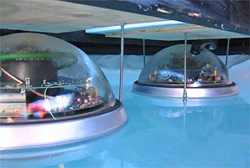To understand this potential discovery, we must first look at the basics of neutrinos as we currently understand them. There are currently 3 known neutrinos: ve, vµ, and vτ. These neutrinos each relate to a charged particle: electron (e), muon (µ), and tau (τ) respectively.

Photo by: D. Hubert/NSF
Neutrinos are the smallest bits of matter we currently know. They are bits of matter which only react to gravity and the weak nuclear force. Because of this, they travel extreme distances and through pretty much all matter with very little interaction.
Very recently, we have had experimental anomolies which hint of a 4th type of neutrino:
In tunnels deep inside a granite mountain at Daya Bay, a nuclear reactor facility some 55 kilometers from Hong Kong, sensitive detectors are hinting at the existence of a new form of neutrino, one of nature’s most ghostly and abundant elementary particles.
This serendipitous discovery (well, not technically a discovery, due to the probabilities involved although other experiments have seen similar results) came about when scientists saw fewer antineutrinos than expected in the output of a nuclear reactor. Along with this, there is potentially new physics to be worked out to explain the excess of electron antineutrinos at an energy of around 5 million electron volts.
